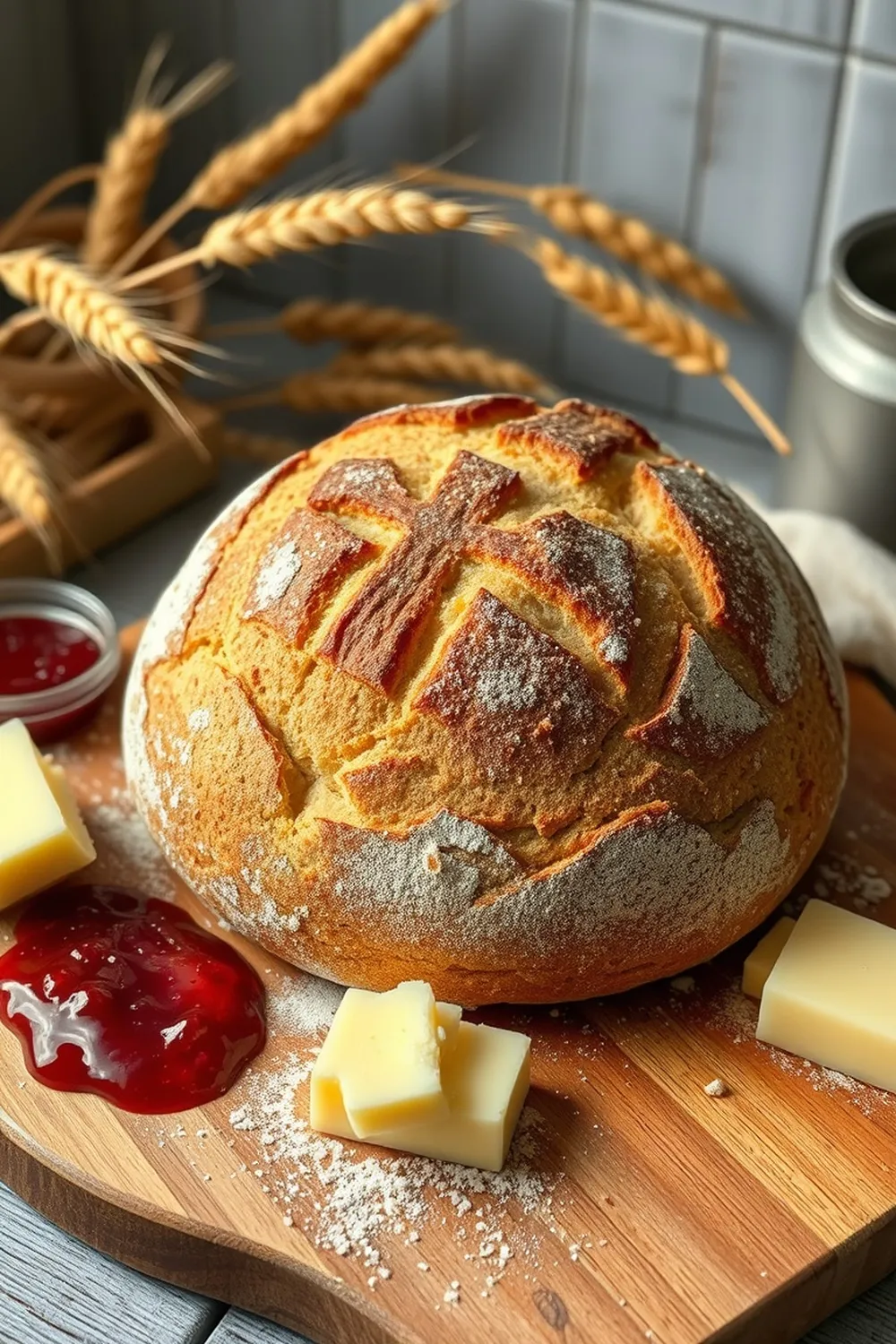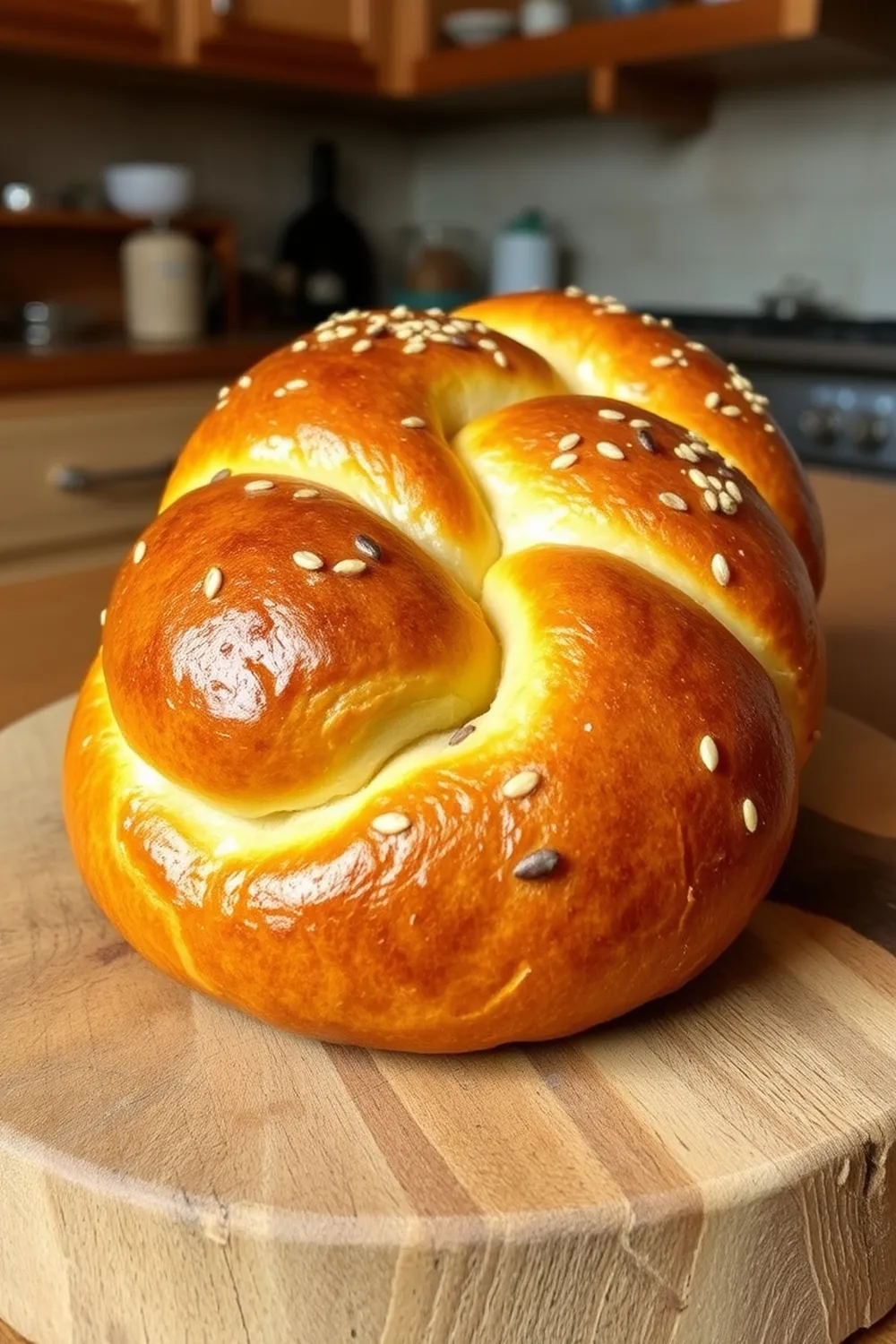- Preheat the oven to 200°C/400°F.
- In a large bowl, combine bread flour, rye flour, salt, and baking soda.
- Gradually add buttermilk to the dry ingredients, stirring until a sticky dough forms.
- Transfer dough to a lightly floured surface. Gently shape into a ball without over-kneading.
- Flatten the dough ball slightly and dust the top with rye flour. Cut a deep cross into the dough.
- Place the dough on a parchment-lined baking sheet. Bake for 30-35 minutes, or until golden brown.
- Cool on a wire rack for at least 2 hours before slicing. Serve fresh with butter or jam.
- Calories:215 kcal25%
- Energy:899 kJ22%
- Protein:10 g28%
- Carbohydrates:65 mg40%
- Sugar:3 mg8%
- Salt:450 g25%
- Fat:15 g20%
Last Updated on 5 months ago by Neha Deshmukh
Rye & Bread Flour Soda Bread Recipe – Easy 30-Minute Bake
Hey everyone! If you’re anything like me, sometimes you just need fresh bread, and you need it fast. This Rye & Bread Flour Soda Bread is my go-to when that craving hits. It’s incredibly simple, comes together in minutes, and the flavour is just… comforting. I first made this when I was missing the hearty breads from a trip to Ireland, and it instantly transported me back! Let’s get baking, shall we?
Why You’ll Love This Recipe
This isn’t your average soda bread. The combination of bread flour and rye flour gives it a wonderful texture – a slightly chewy interior with a beautifully crisp crust. It’s ready in under an hour, from start to finish, and requires minimal kneading. Seriously, minimal! Plus, the subtle tang from the buttermilk adds a depth of flavour that’s just irresistible. It’s perfect for breakfast, a quick lunch, or alongside a hearty soup.
Ingredients
Here’s what you’ll need to whip up a loaf of this deliciousness:
- 2 cup bread flour (about 250g)
- 2 cup rye flour (about 260g)
- 1.5 teaspoon salt (about 8g)
- 1.5 teaspoon baking soda (about 8g)
- 2 cup buttermilk (about 475ml)
- Rye flour (for dusting, as needed)
Ingredient Notes
Let’s talk ingredients for a sec! Using both bread flour and rye flour is key here. Bread flour gives the bread structure, while rye flour adds that lovely, slightly earthy flavour and a beautiful colour.
Buttermilk is essential for that classic soda bread tang and tender crumb. It reacts with the baking soda to create a light and airy texture. Traditionally, Irish Soda Bread was made with whatever flour was available – sometimes wheat, sometimes oats, sometimes a mix! Regional variations are huge, with some adding sugar, raisins, or even caraway seeds. Don’t be afraid to experiment!
Step-By-Step Instructions
Alright, let’s get down to business!
- Preheat your oven to 200°C/400°F. Get that oven nice and hot!
- In a large bowl, whisk together the bread flour, rye flour, salt, and baking soda. Make sure everything is nicely combined.
- Gradually add the buttermilk to the dry ingredients, stirring with a wooden spoon or your hands until a sticky dough forms. Don’t overmix!
- Turn the dough out onto a lightly floured surface. Gently roll and fold it into a ball – we’re not looking for a perfectly smooth dough here, so don’t worry about over-kneading. A rough ball is perfect.
- Flatten the dough ball slightly and dust the top generously with rye flour. Now, carefully cut a deep cross into the dough, going about halfway through. This helps the bread bake evenly.
- Place the dough on a baking tray lined with parchment paper. Bake for 30-35 minutes, or until the bread is golden brown and sounds hollow when tapped on the bottom.
- Let the bread cool on a wire rack for at least 2 hours before slicing. I know, the wait is hard, but it’s worth it! This allows the crumb to set properly.
Expert Tips
Want to make sure your soda bread turns out perfectly? Here are a few things I’ve learned along the way:
- Don’t overmix the dough! This is the biggest mistake people make. Overmixing develops the gluten too much, resulting in a tough bread.
- Scoring is important. The cross allows steam to escape, preventing the bread from cracking unevenly.
- A hot oven is your friend. It helps the bread rise quickly and develop a nice crust.
- Be gentle. Seriously, treat this dough with kindness. It’s a delicate balance!
Variations
This recipe is a great base for experimentation. Here are a few ideas:
- Vegan Adaptation: Substitute the buttermilk with a plant-based alternative like almond milk mixed with a tablespoon of lemon juice or apple cider vinegar. Let it sit for 5 minutes to curdle before using.
- Gluten-Free Adaptation: This is trickier! Gluten-free soda bread can be crumbly. I’ve had success with a blend of gluten-free bread flour, almond flour, and tapioca starch, but it requires some experimentation.
- Spice it Up: Add 1-2 tablespoons of caraway seeds, sunflower seeds, or chopped walnuts to the dry ingredients for extra flavour and texture. My grandma always added a pinch of fennel seeds!
Festival Adaptations
This bread is amazing around St. Patrick’s Day! You can add a handful of raisins or currants to the dough for a traditional touch.
Serving Suggestions
Honestly, this bread is delicious on its own. But if you want to elevate it, try:
- A generous slather of butter (salted, of course!)
- A dollop of your favourite jam or preserves
- Alongside a bowl of hearty soup or stew
- With a slice of cheese and a cup of tea
Storage Instructions
Leftover soda bread is best stored in an airtight container at room temperature for up to 2 days. It tends to dry out quickly, so enjoy it while it’s fresh! You can also freeze slices for longer storage.
FAQs
Got questions? I’ve got answers!
1. Can I use all-purpose flour instead of bread flour? What will be the difference?
You can, but the texture will be slightly different. Bread flour has a higher protein content, which creates a chewier, more structured bread. All-purpose flour will result in a softer, less chewy loaf.
2. What if I don’t have buttermilk? What can I substitute?
No buttermilk? No problem! You can make a quick substitute by adding 1 tablespoon of lemon juice or white vinegar to 2 cups of milk. Let it sit for 5-10 minutes to curdle.
3. Why is scoring the bread important?
Scoring allows steam to escape during baking, preventing the bread from cracking unevenly. It also gives it that classic soda bread look!
4. Can this dough be refrigerated before baking?
While it’s best baked immediately, you can refrigerate the dough for up to 12 hours. It might not rise quite as much, but it will still be delicious.
5. How can I tell if the soda bread is fully baked?
The bread should be golden brown and sound hollow when tapped on the bottom. You can also insert a skewer into the centre – it should come out clean.
6. What’s the best way to store leftover soda bread to keep it fresh?
Store it in an airtight container at room temperature for up to 2 days. For longer storage, freeze slices.










